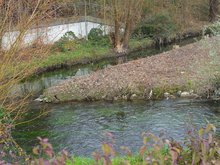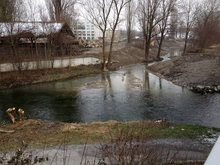News Detail
Improvement of the Chriesbach stream in Dübendorf for nature and leisure
March 11, 2013 |
At one time, the Chriesbach in Dübendorf used to meander naturally through the landscape before merging with the river Glatt. It would often flood nearby fields. When the autobahn was constructed at the end of the 1970s, the level of the Chriesbach was lowered and the stream was heavily concretized. Since then it has been an uninteresting canal. Thanks to the improvement project, the stream should regain a natural form and awake to new life – without compromising on flood protection.
Seating areas and access to the water
The Chriesbach connects the habitats of the animals and plants along its course with those of the River Glatt, into which it flows. It thus fulfils an important ecological network function. The improvement of the Chriesbach will remove the obstacles to fish migration and enable the creation of new, diverse habitats for aquatic life. The stream will also be more attractive to those looking for relaxation, thanks to the increased availability of places to sit, and greater access to the water. In cooperation with Eawag, the Swiss Federal Institute of Aquatic Science and Technology, an open-air laboratory is being created on the Chriesbach in the Eawag grounds. The laboratory will consist of two ponds as well as various measuring equipment for the educational, research and public purposes.
Clearing of vegetation necessary – new planting once construction work is finished
The Chriesbach will be improved along a stretch of around 900 metres. Construction works will be carried out in two stages. The first stage will involve the section from the Neugutstrasse bridge up to where the stream flows into the River Glatt, and will take place this winter. The second stage, upstream of the first, covers the section from the Kriesbach bridge to the new Glattalbahn bridge. This will begin in March with the clearing of trees and scrub along the banks of the stream, which is necessary for the construction works. Larger trees will be spared wherever possible. The actual construction work will begin in April, and should be completed by the end of the year. The banks of the stream will then be replanted with native shrubs and trees.
This improvement project of the Cantonal Department for Waste, Water, Energy and Air (AWEL) is costing around 3.6 million Swiss francs. The federal government, as well as the town of Dübendorf and ewz's 'naturemade star' fund are all supporting the project with significant financial contributions.
More on the subject
Natural river courses - for man and nature More natural
Landscapes with natural streams and rivers are some of the most species-rich habitats in Switzerland. Nature needs diverse waters with varying depths and flow conditions as well as rich bank vegetation, and originally these were to be found meandering across every part of the landscape. These are the only places that many of our native plants and animals can survive or re-establish themselves.
More flood protection
Natural streams and rivers do not necessarily flow in a wider bed, but have a greater total amount of space available to them. In this way they are able to take on more water in the event of a flood, and rarely burst their banks.
More relaxation
People enjoy spending time by natural rivers and streams, to breathe deeply and recover from the hectic pace of everyday life. Watery landscapes in their natural state invite one to take a walk, linger, enjoy, discover and observe nature. Not far from urban areas, there are ideal recreational areas for both old and young alike.
Clean groundwater, clean drinking water
The more diverse a natural watercourse, the better it can remove organic pollutants and clean itself. More water seeps down through natural stream beds and river beds into the ground below. There it is filtered, stored as groundwater and serves us as precious drinking water.
Great value
Technical solutions for flood protection are usually costly and require regular maintenance. Many of these costs can be saved if the stream or river is given an increased amount of space once again, and its bed is formed in a natural way. In the long term, the maintenance of revitalised waters is actually less costly. And the wealth of native plants and animals flourishing there is a priceless asset for us and for future generations.


Improvements made over the past few weeks: the mouth of the Chriesbach, where it flows into the Glatt – before and now
